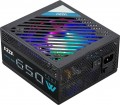+3.3V
The maximum values of current and power that the PSU can provide on individual power lines.
The power line can be simply described as a pair of contacts for connecting a particular load; one of these contacts is “ground” (with zero voltage), and the second has a certain voltage with a plus or minus sign, this voltage corresponds to the voltage of the power line. In this paragraph, it is + 3.3V (such power is present in 20- and 24-pin connectors for motherboards, in SATA power connectors and some other types of connectors).
In general, power and currents are rather specific parameters that the average user rarely needs — mainly when connecting high-power components such as video cards, as well as when starting a PSU without a computer to power other electronics (for example, amateur radio stations). It is also worth mentioning that the sum of the maximum powers on all lines can be higher than the total output power of the PSU — this means that all lines cannot operate at full power at the same time. Accordingly, when the PSU is fully loaded, some of them will produce less power than the maximum possible.
+5V
The maximum current that the PSU is capable of issuing + 5V to the power line. For more information about power lines in general, see "+3.3V". Also note here that + 5V power, in addition to connectors for motherboards (for 20 and 24 pins), is also found in Molex and SATA plugs, as well as some other specific types of connectors.
+12V1
The maximum current that the PSU is capable of delivering to the first power line is + 12V.
For more information about power lines in general, see "+3.3V". Here it is worth mentioning that 12 V is the most popular voltage among computer power connectors. It is used in almost all such connectors (with a few exceptions), and some plugs (for example, additional PCI-E power for 6 or 8 connectors) use only 12-volt lines — and in the + 12V format. And the division of + 12V power into several separate lines is used for safety purposes — in order to reduce the current flowing through each individual wire, and thus prevent excessive load and overheating of the wiring. However, some manufacturers do not specify the maximum current for individual + 12V lines and give only a general value in the characteristics; in such cases, this number is indicated in this paragraph.
-12V
The maximum current that the PSU is capable of issuing to the power line is -12V.
For more information about power lines in general, see "+3.3V". Here it is worth mentioning that 12 V is the most popular voltage among computer power connectors. However, most often it is used in the + 12V format; and the -12V line performs mainly a service function, it is almost never found in other connectors, except for the motherboard power plug (for 20 or 24 pins).
+12V
The maximum power that the PSU is capable of delivering to the + 12V power line.
See "Maximum current and power" for details on power lines in general. Here it is worth mentioning that 12 V is the most popular voltage among computer power connectors. It is used in almost all such connectors (with a few exceptions), and some plugs (for example, additional PCI-E power for 6 or 8 connectors) use only 12-volt lines — and in the + 12V format. So this indicator is one of the most important characteristics of any PSU.
Note that many power supplies have several separate + 12V power lines. In such cases, the total power is indicated here, which, usually, is divided equally between the lines.
-12V
The maximum power that the PSU is capable of delivering to the power line is -12V.
See "Maximum current and power" for details on power lines in general. Here we note that -12V is a rather specific format used exclusively in power plugs for motherboards — to supply power to individual motherboard components that require reverse polarity.
Lighting
The power supply has its own
backlight. This function does not affect the technical characteristics, its role is purely aesthetic, and therefore it is worth paying attention to power supplies with backlight, first of all, for those who care about the individual design of their own PC. Note that the specific functionality of the backlight may be different. The simplest systems are single-colour, more expensive solutions may provide several colour options, and the most advanced type of backlight in this regard is RGB, with the ability to select almost any shade at the request of the user. In addition, some systems are able to synchronize with the backlight of other PC components; See "Light Timing" below for more on this.
Lighting sync
Synchronization technology provided in the illuminated power supply (see above).
Synchronization itself allows you to “match” the backlight of the PSU with the backlight of other system components — the motherboard, processor, graphics card, case, keyboard, mouse, etc. Thanks to this matching, all components can change colour synchronously, turn on / off at the same time, etc. etc. The specific features of the operation of such a backlight depend on the synchronization technology used, and, usually, each manufacturer has its own (Aura Sync for Asus, RGB Fusion for Gigabyte, etc.). The compatibility of the components also depends on this: they must all support the same technology. So the easiest way to achieve backlight compatibility is to collect components from the same manufacturer. There are also power supplies with multi compatibility — that is, they support several synchronization standards at once; however, the specific set of compatible standards for such models may be different, it must be clarified before purchase.

